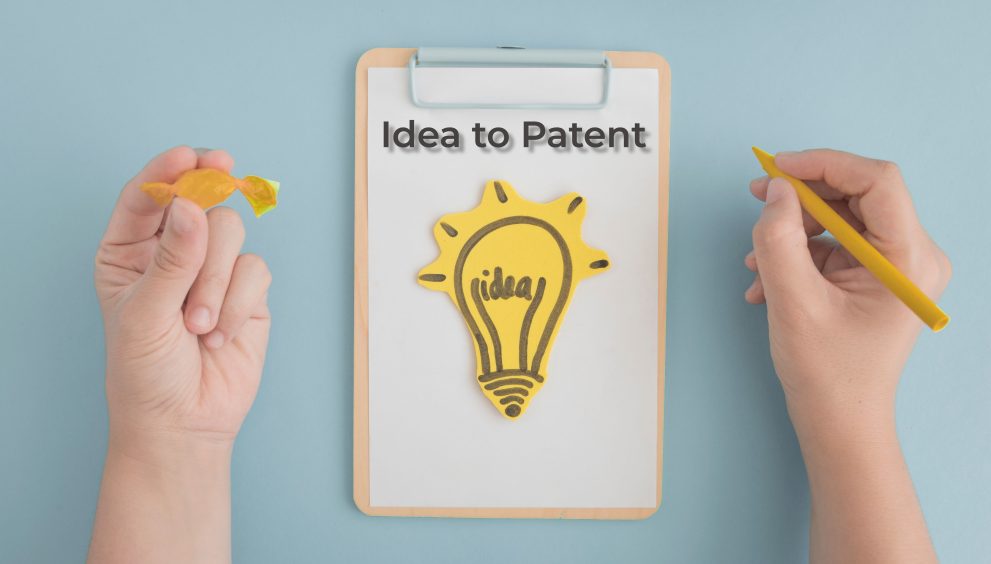FROM IDEA TO PATENT: A GUIDE TO PROTECTING YOUR INTELLECTUAL PROPERTY IN INDIA

Author: Pritisha Mahinta
Student at Presidency University, bangalore
KEY TAKEAWAYS –
- Intellectual property is a category of property that includes intangible creations of the human intellect.
- A patent is a legal document granting the holder exclusive rights to an invention, preventing others from making, using, or selling the invention without permission.
- Understanding patents and their process is crucial for inventors and businesses to protect and leverage their innovations effectively.
INTRODUCTION –
In an era defined by innovation and creativity, protecting one’s Intellectual Property has never been more crucial. Ideas, once the domain of private thought, now drive the engines of industry, technology, and culture. For innovators and entrepreneurs, securing a patent is not merely a legal formality; it is a strategic move to safeguard their creations and ensure their hard work translates into tangible benefits.
From Idea to Patent: A Guide to Protecting Your Intellectual Property in India serves as a comprehensive resource for anyone navigating the complex landscape of intellectual property rights in India. This guide demystifies the patenting process, providing a step-by-step pathway from the conception of an idea to obtaining a patent. It caters to inventors, businesses, legal professionals, and academics alike, offering insights and practical advice tailored to the unique aspects of the Indian legal framework.
India, with its burgeoning ecosystem of startups and research institutions, presents both opportunities and challenges for inventors. The country’s patent laws have evolved significantly, aligning more closely with international standards while maintaining provisions unique to its socio-economic context. Understanding these nuances is essential for anyone seeking to protect their innovations within India’s borders and beyond.
WHAT IS PATENT –
A Patent is a form of Intellectual Property that grants the patent holder exclusive rights to an invention. This means the patent holder has the legal right to prevent others from making, using, selling, or distributing the patented invention without permission for a certain period.
So, a patent is a legal document that provides the inventor exclusive rights to their invention for a limited time, typically 20 years from the filing date of the application.
Types of Patents –
1. Utility Patents: Granted for new and useful inventions or discoveries of processes, machines, manufactured products, or compositions of matter.
2. Design Patents: Granted for new, original, and ornamental designs for an article of manufacture.
3. Plant Patents: Granted for new and distinct, invented, or discovered asexually reproduced plants.
IMPORTANCE OF PATENT –
Patents play a crucial role in fostering innovation and economic growth. Here are several key reasons why patents are important:
- Encouragement of Innovation –
Incentives for Inventors: Patents provide inventors with the exclusive right to benefit commercially from their inventions, offering a significant incentive to innovate and invest in research and development.
Protection from Imitation: By granting a temporary monopoly, patents protect inventors from competitors who might otherwise copy and profit from their inventions without incurring the costs of innovation.
- Economic Growth –
Commercialization: Patents enable inventors to commercialize their inventions, leading to the creation of new products, services, and industries, which in turn creates jobs and stimulates economic activity.
Attracting Investment: Patents can attract investors and venture capitalists who are more likely to fund projects with protected intellectual property, seeing it as a safer and more profitable investment.
- Public Disclosure and Knowledge Sharing –
Technical Information: Patents require the detailed disclosure of how the invention works, which becomes publicly available. This promotes the sharing of knowledge and can inspire further innovation by others.
Avoiding Duplication of Effort: Publicly available patent information helps other researchers and inventors understand what has already been done, preventing redundant research and encouraging the pursuit of new ideas.
- Competitive Advantage –
Market Exclusivity: Patents provide a competitive edge by allowing patent holders to be the sole provider of a new technology or product for a certain period, helping to establish a strong market position.
Licensing Opportunities: Patent holders can license their patents to others, generating revenue and allowing other companies to use and build upon the technology.
- Legal Protection and Enforcement –
Preventing Infringement: Patents provide legal means to prevent others from using, making, or selling the patented invention without permission, thus protecting the inventor’s market share and investment.
Basis for Litigation: In case of infringement, patents provide a strong basis for legal action to seek remedies such as damages or injunctions.
- Fostering Collaboration –
Partnerships and Joint Ventures: Patents can facilitate partnerships and collaborations between companies and research institutions, leveraging complementary strengths and technologies to drive further innovation.
Technology Transfer: Universities and research institutions can patent their inventions and license them to businesses, facilitating technology transfer and commercialization of academic research.
- Global Competitiveness –
International Trade: Patents can enhance a country’s competitiveness in the global market by protecting domestic inventions abroad, encouraging international trade and investment.
Standard Setting: Patents are often involved in setting industry standards, influencing the development and adoption of new technologies worldwide.
RIGHTS CONFERRED TO PATENT OWNERS –
Patent owners are granted a bundle of exclusive rights that allow them to control the use and commercialization of their invention. These rights help protect their intellectual property and provide a mechanism for monetizing their inventions. Here are the primary rights conferred to patent owners:
- Exclusive Right to Use – Patent owners have the exclusive right to make, use, and apply the patented invention in any process or production.
- Exclusive Right to Sell – Patent owners can sell the patented invention or products made using the patented process. This includes the right to offer the invention for sale.
- Exclusive Right to Import – Patent owners have the exclusive right to import the patented invention or products produced with the patented process into the country where the patent is granted.
- Licensing and Assignment – Patent owners can license their rights to others. This allows another party to use the patented invention, usually in exchange for royalties or a licensing fee. Patent owners can transfer (assign) their patent rights to another entity, either wholly or partially. This is a common practice in mergers, acquisitions, or business deals.
- Right to Prevent Infringement – Patent owners can take legal action against any party that uses, makes, sells, or imports the patented invention without authorization. This includes the right to seek injunctions to stop the infringing activities and to claim damages for the infringement.
- Right to Sue for Past Infringements – Patent owners can sue for infringements that occurred before they were able to take action, provided these infringements happened during the term of the patent.
- Right to Mark Products – Owners have the right to mark their products with the patent number, which serves as a public notice of the patent protection and can act as a deterrent to potential infringers.
- Right to Control Distribution – Patent owners can control how their patented products are distributed and marketed. They can set terms and conditions for distribution to maximize their market reach and profitability.
- Right to Participate in International Trade –Patents are territorial, patent owners can file for international protection (e.g., through the Patent Cooperation Treaty) to secure their rights in multiple countries, enabling them to control and exploit their invention globally.
OVERVIEW OF PATENT ACTS IN INDIA –
India’s patent laws have undergone significant transformations to align with international standards and address the needs of its growing innovation ecosystem. The primary legislation governing patents in India is the Patents Act, 1970, which has been amended multiple times to adapt to changing economic, technological, and international landscapes. Here’s an overview of the key aspects of India’s patent laws:
The Patents Act, 1970 – The Patents Act, 1970, marked a pivotal moment in India’s legislative history, establishing a structured framework for patent protection. The Act defines what constitutes a patentable invention, the rights of patentees, and the processes involved in obtaining and enforcing patents.
Under the Act, an invention must satisfy three key criteria to be patentable:
Novelty: The invention must be new and not disclosed to the public anywhere in the world.
Inventive Step: The invention must involve a technical advance or an improvement that is not obvious to someone skilled in the relevant field.
Industrial Applicability: The invention must be capable of being made or used in an industry.
Certain categories of inventions are excluded from patentability, such as:
– Frivolous or contrary to natural laws.
– Injurious to public health or morality.
– Mere discovery of a scientific principle or abstract theory.
– Methods of agriculture or horticulture.
– Inventions relating to atomic energy.
PATENT PROCESS IN INDIA –
Securing a patent in India involves several steps, from the conception of an idea to obtaining legal protection for the invention. The process is governed by the Indian Patents Act, 1970, and subsequent amendments. Here’s a detailed guide to the patent application process in India:
1. Conceiving the Idea – Before filing a patent, the Applicant must have a concrete and novel invention. He must ensure that the idea or invention meets the patentability criteria: novelty, inventive step (non-obviousness), and industrial applicability.
2. Conducting a Patent Search – He must then do a thorough patent search to determine if the invention is unique. This can be done through:
Indian Patent Office (IPO) Database: It is used for checking existing patents or pending applications in India.
International Databases: Resources like the European Patent Office (EPO) or the World Intellectual Property Organization (WIPO) databases to ensure global novelty.
3. Drafting the Patent Application – Drafting a patent application requires technical and legal expertise. The application should include:
Title: A brief title of the invention.
Abstract: A summary of the invention.
Specification: Detailed description of the invention, including:
Background and prior art.
Detailed description of the invention.
Claims defining the scope of the patent protection.
Drawings, if necessary.
The author can file either a provisional application or a complete specification. A provisional application secures a priority date and gives you 12 months to file the complete specification.
4. Filing the Patent Application – Then the patent application must be submitted to the Indian Patent Office either online through the official portal or physically at one of the Patent Office branches in Delhi, Mumbai, Kolkata, or Chennai. The application should include:
– Form 1 (Application for Grant of Patent)
– Form 2 (Provisional/Complete Specification)
– Form 3 (Statement and Undertaking under Section 8)
– Form 5 (Declaration as to Inventorship)
– Form 26 (Authorization of Patent Agent, if applicable)
– Fees as per the fee schedule
5. Publication of the Application – The patent application is published in the official journal 18 months from the filing date or priority date. If the person wants early publication, he can request it by filing Form 9, and the application will be published within one month of the request.
6. Request for Examination – Request of the examination of application can be done by filing Form 18 or Form 18A (for expedited examination). This must be done within 48 months from the filing date or priority date. The Indian Patent Office will examine the application for compliance with patentability criteria.
7. Examination and Objections – The examiner reviews the application and issues an Examination Report. This may include objections or requirements for amendments. The applicant must respond to the examination report, addressing any objections raised, within six months from the date of the report.
8. Hearing – If necessary, the applicant may request a hearing to present arguments or clarifications regarding the objections raised. The Controller of Patents may schedule a hearing before making a decision on the grant of the patent.
9. Grant of Patent – Once all objections are resolved, the patent is granted, and the grant is published in the official journal. The Applicant will receive a certificate of the patent grant.
10. Post-Grant Opposition – After the grant of a patent, there is a period during which third parties can file an opposition (within 12 months from the date of publication of the grant). This is known as post-grant opposition and is adjudicated by the Opposition Board.
11. Maintenance of Patent – To keep the patent in force, the patent owner must pay annual renewal fees starting from the third year of the patent. Failure to pay these fees will result in the lapse of the patent.
12. Enforcement of Patent Rights – As a patent holder, he will have the exclusive right to prevent others from making, using, selling, or importing the patented invention without his consent. Or else he can take legal action against infringers to enforce his patent rights.
CONCLUSION –
Patents are a vital component of the innovation ecosystem. They provide inventors with the necessary incentives and protection to invest in and develop new technologies, while also contributing to economic growth, knowledge dissemination, and technological advancement. Understanding patents and their process is crucial for inventors and businesses to protect and leverage their innovations effectively. By balancing the interests of inventors and the public, patents help to drive continuous progress and improvement across various fields of technology.
The rights conferred to patent owners provide them with powerful tools to control the use, production, and commercialization of their inventions. These rights help ensure that inventors can reap the benefits of their creativity and investment, thereby encouraging further innovation and contributing to economic and technological progress.
Navigating the patent process in India requires meticulous attention to detail and adherence to legal requirements. Engaging with a registered patent agent or attorney can significantly streamline the process, ensuring that your invention is adequately protected. By following these steps, you can secure a patent that safeguards your intellectual property and provides a competitive edge in the market.
 English
English 



